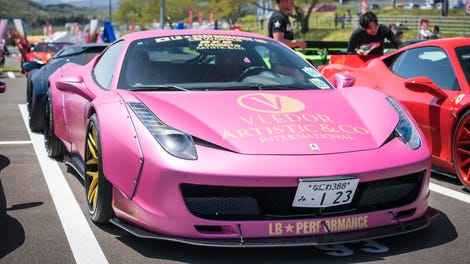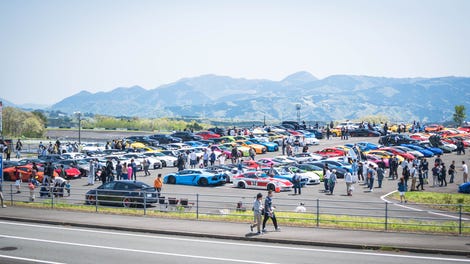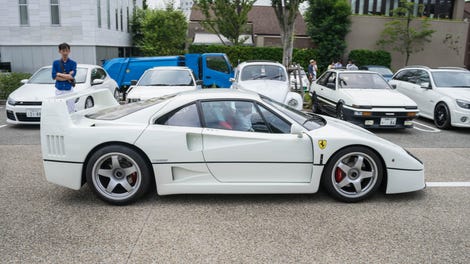Here’s an embarrassing personal detail: despite being an automotive writer, until very recently, I had never watched a race live. I know, that’s like a penguin saying they’ve never been to Antarctica. I’ve done a few track events with some spirited driving on display, but it’s not quite the same as full-on racing. But as firsts go, experiencing Japan’s Super GT race at Fuji Speedway wasn’t a bad place to start.
Advertisement
The Super GT race series is, without a doubt, Japan’s most popular domestic motorsport series as well the top-tier sports car race series in the country. Only the Formula One Japanese Grand Prix tops it for audience attendance. The Fuji GT 500 kilometer race draws a crowd in excess of 100,000 people.
The Super GT series is relatively young; the first race was held in 1993. Over the years it developed and evolved through several iterations before finally becoming the modern Super GT series in 2005. You’ve likely seen some of your favorite Japanese performance cars, like Supras and NSXs and Skylines, duking it out at these races on YouTube or in video games.
Think of it as Japan’s version of the British Touring Car Championship or Germany’s DTM. Super GT rules follow closely to the latter. In 2014, the big V8s were replaced with smaller turbocharged four-cylinder engines in the GT500 category. There’s also a lower GT300 series, similar to GT3 racing.
They’re called GT500 and GT300 because in the old days the cars had around 500 and 300 horsepower, respectively. Needless to say, race cars are a lot more powerful now. Today GT500 cars have in excess of 600 HP while GT300 cars can have anywhere between 400 to 500 HP. To keep a level playing field, cars with a power or speed advantage during races get a weight penalty.
Advertisement
There are eight rounds in a season of Super GT—seven races are held in Japan with one in Thailand at the Chang International Circuit. Fuji hosts two races each year, first in early May and another in early August. Other host circuits include Suzuka, Motegi, Sugo, Autopolis, and Okayama.
Fuji Speedway is about a 90 kilometer drive from Tokyo, so in theory it should have taken me roughly 90 minutes to get there. However, the fact this race is always held on the first day of the Golden Week vacation time, and its massive popularity, meant traffic on the motorway to Fuji on top of the traffic on the normal roads as well as traffic inside the car parks at Fuji. It was like traffic-ception.
Once I got there, all was well.
What I enjoyed most about Super GT was its emphasis on crowd entertainment. It’s all about making the fans happy here. You’ve got diehard motorsports fans dressed head to toe in their favorite team’s outfits, photographers around every corner, and families making a day out of it.
That was great to see, as I always hear horror stories about the declining interest in cars in Japan. There’s even a whole section in the grandstands for supporters of Subaru, Honda, Nissan and Lexus. Don’t forget, Fuji Speedway is Lexus’ home track. The ‘F’ in their high performance cars does mean Fuji.
Speaking of, there were two Prius-shaped cars racing in the GT300 category. The base design and name were probably the only thing those cars shared with what your Uber driver has. Instead of a miserable 1.8-liter hybrid, it’s got a 3.4-liter mid-mounted V8 hybrid. More importantly there’s no sign of CVT anywhere. It’s the best Prius ever.
Advertisement
Sponsored
Since being in Japan nothing else I’ve witnessed close to this level of excitement and enthusiasm. Proof of that is the sheer amount of people at the grid walk; it looks like a department store on Christmas Eve, but with less punching and kicking of the elderly.
As great as it is to sit and listen to the 30-plus cars fly past the main straight at 300 km/h, or 186 mph for those who read speed differently, there’s the added enjoyment of walking around Fuji and seeing the action from different vantage points. If you do, you’ll notice people camping out at literally every corner. One of the highlights for me was seeing a man and his dog enjoying the race together.
The GT300 class had a whole variety of cars on the grid, from a Gulf Racing Porsche 911 to the aforementioned crazy Prius and Toyota 86s. The GT500 class only features cars from Japanese manufacturers, with Lexus’ LC500 being the newest. The LC500 actually took a 1-2-3 finish in the GT500 class, while the RC F GT3 shared the GT300 podium with the Mercedes AMG GT3 and Porsche 911 GT3 R.
One challenge you’ll find at the Super GT race is everything is in Japanese. The (very loud) commentary is all done in the local language by far too enthusiastic people. All that means if you’ll have to use the live app to keep up to date with the position of the cars or just look at the matrix score board on the main straight.
If you want to kill some time, some of the manufacturers also put up displays and booths to show some of the cars you can buy in real life. Subaru had a the road version of the BRZ, Audi had the R8, Mercedes-AMG had the GT, Honda had their new NSX center stage, Nissan showed a GT-R, and Lexus’ new LC500 coupe got some attention.
Oddly enough, Toyota didn’t have a Prius on display.
Advertisement
Advertisement
Super GT is one of the best places to immerse yourself with other gearheads in Japan. There’s an enthusiasm here you just don’t find at any other meet or event. It’s not particularly expensive to go to—a double costs about ¥10,000, or $88.
Is worth going and enduring all the traffic? Absolutely, even if only to see that Prius put in work around the track.
Ken Saito is a writer based in Japan. A Car Nerd’s Guide To Japan is an ongoing Jalopnik series.















